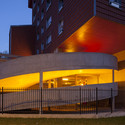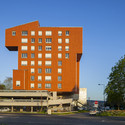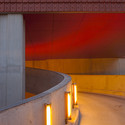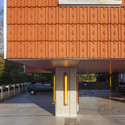
-
Architects: Edouard Francois
- Area: 4350 m²
- Year: 2013
-
Photographs:Paul Raftery

Text description provided by the architects. Our project was born on the site of an abandoned police station, just beyond the last housing blocks of Ris Orangis, a suburb of Paris. At the city’s edge, the site faced an impenetrable jungle with rotting caravans and the ruins of a chateau.

In these edge city conditions, only the city’s exit was indicated clearly by street signage. The question of entry thus became obsessional. The dispersing movement of the place needed to be inversed into a kind of centripetal attraction. In order to do this, we needed to recreate an entry. It is from this idea that the “Orange of Ris” was born. It is not simply a building but a positive sign at the entry to the city, voluntarily colorful and full of endearing materiality.

The building is not painted but instead is material orange. It is made of terracotta tiles of often found on the roofs of houses and industrial hangars. A thick, scaly material, full of relief, that gives the impression of a powerful shell. Rich and desirable, it makes up for the surrounding seventies buildings that are as poor as toast with neither butter nor jam.

The material is suspended in the air, like a flag, without relationship to the ground. It sits on an exposed, open-air parking garage, designed like a museum exhibition space and lit with orange lights as a signal in the night...or an obsession. The concrete structure is powerful enough to elevate the mass.

At the entry, the columns and beams are missing; only an isolated concrete mass carries the weight of the building; it was dimensioned to make up for the absence of structure. Inside, everything is loadbearing, like the deck of a bridge. The walls are of thick concrete and all the façades are beams. Sound resonates as if in a medieval dungeon.

Engraved in the side of the concrete mass is my family’s coat of arms, with its appropriate motto “Pour de vrai” (“for real”). L’Orange is surrounded with a classic spear-tipped fence, as one would find around a chateau. A fence wraps around the building tightly, protecting only the building whose estate is the view itself. The ground treatment is mineral, without trees or plants, fashioned after Japanese zen gardens with immense stones that are placed on gravel.

The raking of the garden is its only expression over time. I love the fanatic density of this object without a terrain, cantilevering beyond its fences the exact opposite of the neighboring conditions, where the ground is nothing but abandoned and empty. The fences, the lamps, the density of the building with its enclosure, and the engraved coat of arms work to give a sense of security and permanence, similar to foundations and religious buildings.





























